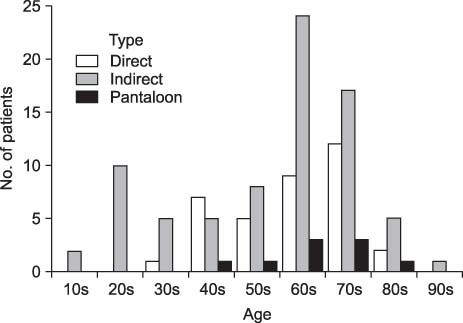J Korean Surg Soc.
2010 Aug;79(2):137-142. 10.4174/jkss.2010.79.2.137.
Clinical Analysis of Inguinal Hernia in Adult Using Prolene Hernia System
- Affiliations
-
- 1Department of Surgery, Hallym University College of Medicine, Chuncheon, Korea. biogra@hallym.or.kr
- 2Department of Pathology, Hallym University College of Medicine, Chuncheon, Korea.
- 3Department of Internal Medicine, Hallym University College of Medicine, Chuncheon, Korea.
- 4Department of Emergency Medicine, Hallym University College of Medicine, Chuncheon, Korea.
- KMID: 2211984
- DOI: http://doi.org/10.4174/jkss.2010.79.2.137
Abstract
- PURPOSE
The aim of this study was to detail clinical experiences with a type of tension-free herniorrhaphy using the prolene hernia system (PHS) and analyze the system's usefulness.
METHODS
We retrospectively reviewed the medical records of 122 patients who underwent an inguinal hernia repair using PHS between March 2004 and August 2008.
RESULTS
There were 116 male and 6 female patients ages 14 to 99; 79 indirect, 33 direct, 10 pantaloon hernias. The right inguinal hernias were more frequent (64.7%). The mean operative time for inguinal hernia repair using PHS was 45.2+/-1.5 minutes and the mean postoperative hospital stay was 3.5+/-1.5 days (101+/-82.9 hours). The most frequent combined disease was hypertension. The most frequent complication of PHS repair was hematoma. The mean number of used analgesics was 3.1+/-3.3. There were no postoperative recurrences.
CONCLUSION
Tension-free herniorrhaphy using PHS is thought to be a useful method of inguinal hernia repair in adults because it offers lower postoperative pain, shorter operation time and shorter postoperative hospital stay.
Keyword
MeSH Terms
Figure
Reference
-
1. Bassini E. Nuovo metodo per la cura radicale hernia inguinale. Atti Conger Assoc Med. 1887. 2:179.2. Lichtenstein IL, Shulman AG. Ambulatory outpatient hernia surgery. Including a new concept, introducing tension-free repair. Int Surg. 1986. 71:1–4.3. Rutkow IM, Robbins AW. "Tension-free" inguinal herniorrhaphy: a preliminary report on the "mesh plug" technique. Surgery. 1993. 114:3–8.4. Gilbert AI, Graham MF, Voigt WJ. A bilayer patch device for inguinal hernia repair. Hernia. 1999. 3:161–166.5. Awad SS, Fagan SP. Current approaches to inguinal hernia repair. Am J Surg. 2004. 188:9S–16S.6. Nyhus LM, Condon RE. Hernia. 1995. 4th ed. Philadelphia: J.B. Lippincott;3–199.7. Abrahamson J. Zinner MJ, Schwartz SI, Ellis H, editors. Hernias. Maingot's Abdominal Operations. 1989. 10th ed. London: Prentice Hall International;506.8. Sanjay P, Woodward A. Local versus general anaesthesia with Prolene Hernia System mesh for inguinal hernia repair: early and long-term outcomes. Dig Surg. 2008. 25:347–350.9. Choi CJ, Park KJ, Kim SH. Comparison of three types of hernioplasty using meshes for adult inguinal hernia: lichtenstein, mesh-plug, prolene hernia system. J Korean Surg Soc. 2009. 76:109–114.10. You JM, Lee KM, Choi UJ. Direct comparison of PHS(R) and Perfix(R) herniorrhaphy under local anesthesia. J Korean Surg Soc. 2007. 72:57–62.11. Lee YT, Yang YS, Lee YJ, Ko SJ. A tension-free herniorrhaphy using the prolene hernia system: clinical experiences. J Korean Surg Soc. 2008. 74:361–365.12. Murphy JW. Use of the prolene hernia system for inguinal hernia repair: retrospective, comparative time analysis versus other inguinal hernia repair systems. Am Surg. 2001. 67:919–923.13. Jung SW, Heo TG, Lee JM, Choi PW, Park JH, Lee MS, et al. Clinical analysis of 473 cases of inguinal hernia in adult patients. J Korean Surg Soc. 2008. 75:109–115.14. Kim HC, Chung M. 120 cases of hernia repair with bilayer patch (prolene hernia system). J Korean Surg Soc. 2006. 70:204–208.15. Millikan KW, Kosik ML, Doolas A. A prospective comparison of transabdominal preperitoneal laparoscopic hernia repair versus traditional open hernia repair in a university setting. Surg Laparosc Endosc. 1994. 4:247–253.16. McGillicuddy JE. Prospective randomized comparison of the Shouldice and Lichtenstein hernia repair procedures. Arch Surg. 1998. 133:974–978.17. Ferzli GS, Edwards ED, Khoury GE. Chronic pain after inguinal herniorrhaphy. J Am Coll Surg. 2007. 205:333–341.18. Callesen T, Bech K, Kehlet H. Prospective study of chronic pain after groin hernia repair. Br J Surg. 1999. 86:1528–1531.19. Poobalan AS, Bruce J, King PM, Chambers WA, Krukowski ZH, Smith WC. Chronic pain and quality of life following open inguinal hernia repair. Br J Surg. 2001. 88:1122–1126.20. Cunningham J, Temple WJ, Mitchell P, Nixon JA, Preshaw RM, Hagen NA. Cooperative hernia study. Pain in the postrepair patient. Ann Surg. 1996. 224:598–602.21. Hasegawa S, Yoshikawa T, Yamamoto Y, Ishiwa N, Morinaga S, Noguchi Y, et al. Long-term outcome after hernia repair with the prolene hernia system. Surg Today. 2006. 36:1058–1062.22. Awad SS, Yallampalli S, Srour AM, Bellows CF, Albo D, Berger DH. Improved outcomes with the Prolene Hernia System mesh compared with the time-honored Lichtenstein onlay mesh repair for inguinal hernia repair. Am J Surg. 2007. 193:697–701.23. EU Hernia Trialists Collaboration. Mesh compared with non-mesh methods of open groin hernia repair: systematic review of randomized controlled trials. Br J Surg. 2000. 87:854–859.
- Full Text Links
- Actions
-
Cited
- CITED
-
- Close
- Share
- Similar articles
-
- An Adult Right-sided Bochdalek Hernia Accompanied with Hepatic Hypoplasia and Inguinal Hernia
- Comparing of Complications of Inguinal Hernia Repair Using Prolene Hernia System
- Clinical Analysis of Femoral Hernia in Adult
- Amyand's Hernia with Periappendicular Abscess
- Comparison of Three Types of Hernioplasty Using Meshes for Adult Inguinal Hernia: Lichtenstein, Mesh-plug, Prolene Hernia System


